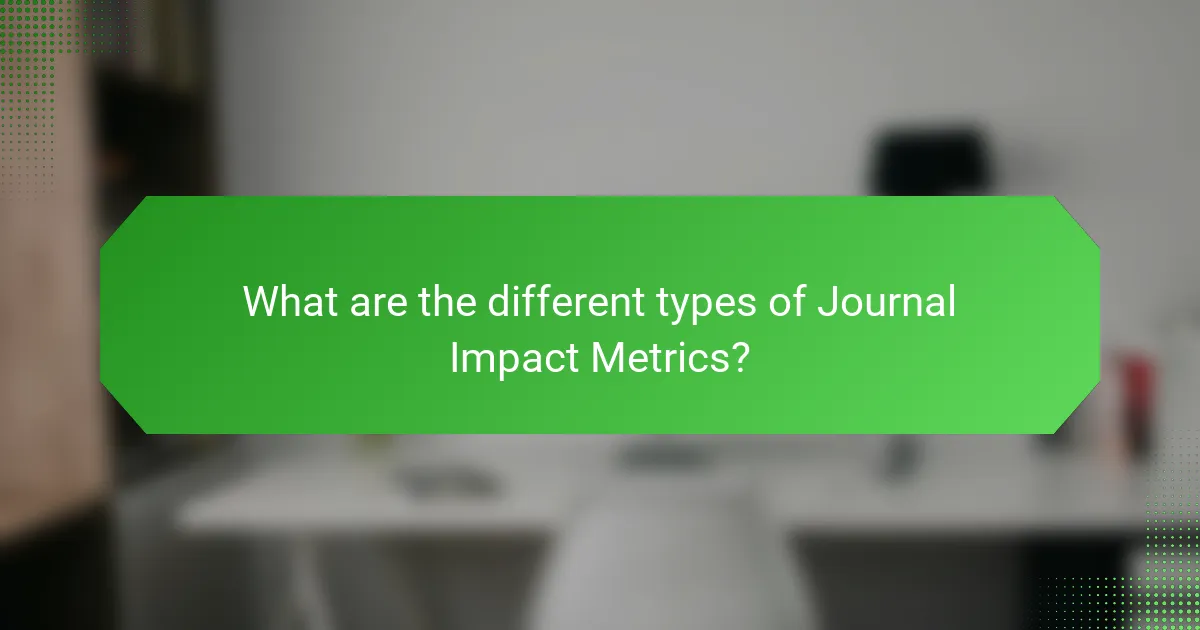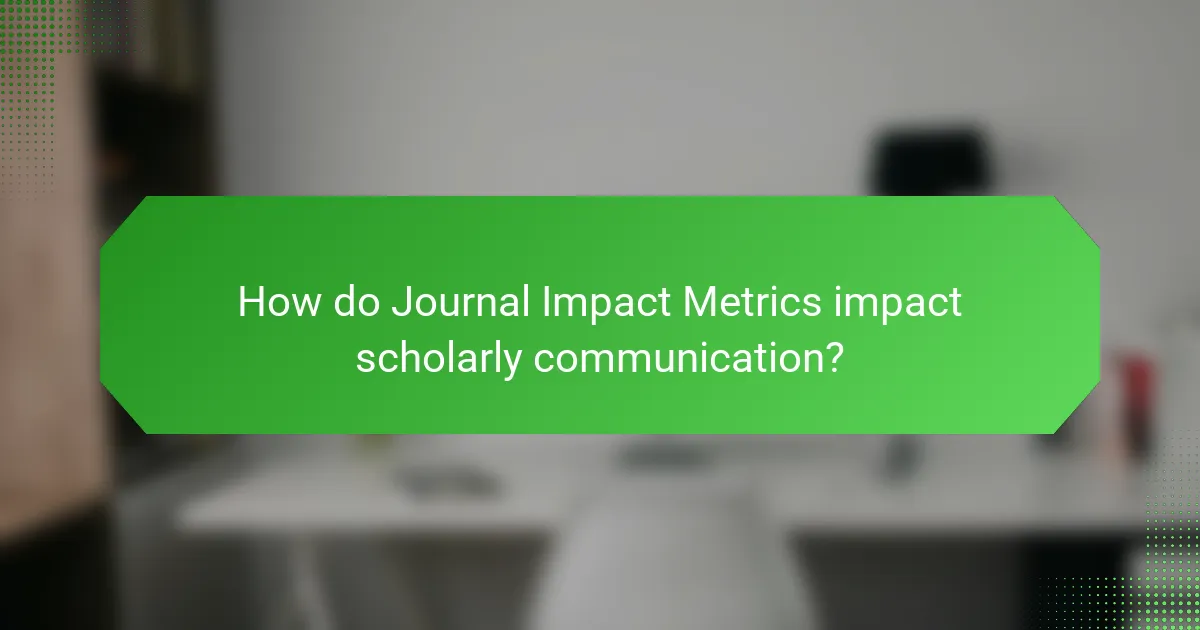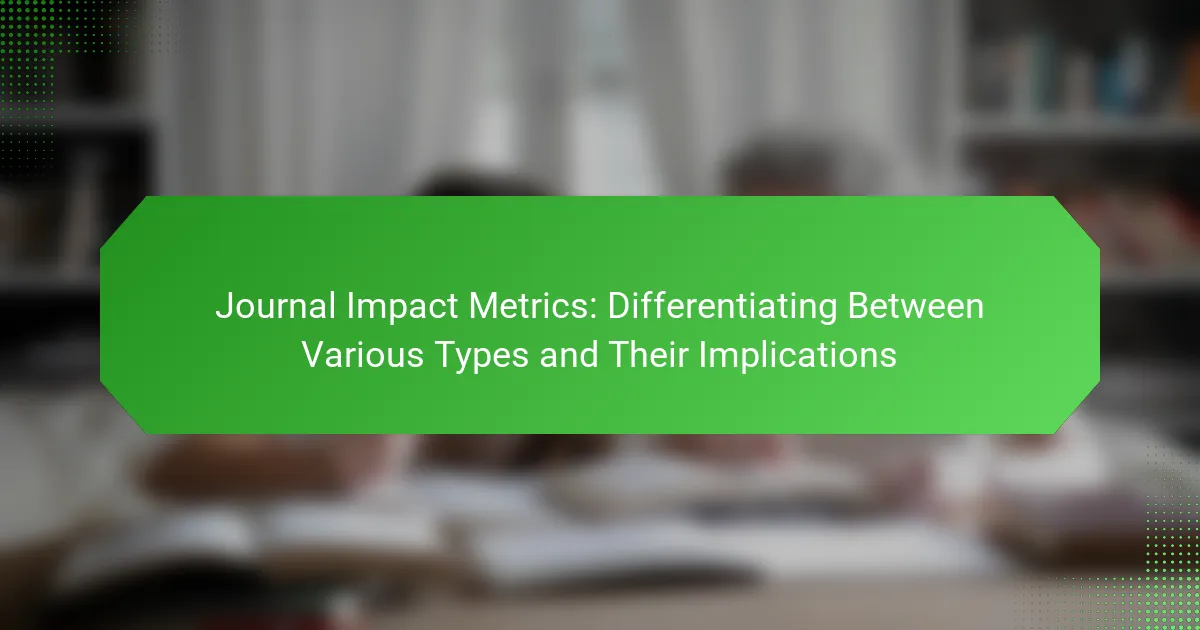Journal Impact Metrics are quantitative measures that evaluate the influence and quality of academic journals, primarily through citation frequency. Key metrics include the Journal Impact Factor, Eigenfactor Score, and Article Influence Score, each providing distinct insights into journal performance and influence. These metrics play a vital role for researchers in selecting publication venues, as well as informing institutions and funding bodies about the impact of scholarly communication. The article delves into the various types of Journal Impact Metrics, their implications for academic publishing, and their influence on research quality, funding decisions, and academic advancement.

What are Journal Impact Metrics?
Journal Impact Metrics are quantitative measures used to evaluate the influence and quality of academic journals. These metrics assess the frequency with which articles in a journal are cited in a given timeframe. Commonly used metrics include the Impact Factor, which calculates the average number of citations to recent articles. Other metrics include the h-index and CiteScore, which provide additional perspectives on journal performance. These metrics are crucial for researchers when selecting where to publish their work. They also inform institutions and funding bodies about the impact of scholarly communication. Various organizations, such as Clarivate Analytics and Scopus, provide these metrics, ensuring their widespread use in academia.
How do Journal Impact Metrics influence academic publishing?
Journal Impact Metrics significantly influence academic publishing by determining the perceived quality and prestige of journals. These metrics, such as the Impact Factor, help researchers decide where to submit their work. Higher impact metrics often correlate with stricter acceptance rates and broader visibility. Consequently, authors may prioritize submitting to high-impact journals to enhance their academic reputation. Additionally, institutions often use these metrics for evaluating faculty performance and research funding. A study by Archambault et al. (2015) found that journals with higher impact metrics attract more submissions and citations. This creates a competitive environment where researchers strive to publish in top-tier journals, thereby shaping the landscape of academic publishing.
What are the key components of Journal Impact Metrics?
The key components of Journal Impact Metrics include citation analysis, impact factor, and h-index. Citation analysis measures how often articles from a journal are cited in other works. The impact factor is calculated by dividing the number of citations in a given year by the number of articles published in the previous two years. The h-index reflects both the number of publications and the number of citations per publication, providing a comprehensive view of a journal’s influence. Other components may include Eigenfactor score and Article Influence Score, which assess the journal’s overall impact on the academic community. These metrics are widely used to evaluate the quality and reach of academic journals.
How are Journal Impact Metrics calculated?
Journal Impact Metrics are calculated primarily using citation data. The most common metric, the Impact Factor, is derived from the number of citations received by articles published in a journal over a specific period. This is typically a two-year window. To compute the Impact Factor, the total number of citations in the given period is divided by the total number of articles published in that same period.
Other metrics, such as the h-index, consider both the number of citations and the number of publications by a journal. The h-index reflects the maximum number of articles that have received at least that many citations.
These calculations are often based on data from citation databases like Web of Science and Scopus. The reliability of these metrics is supported by their widespread use in academic evaluations and funding decisions.
Why are Journal Impact Metrics important for researchers?
Journal Impact Metrics are important for researchers because they provide a quantitative measure of a journal’s influence within its field. These metrics help researchers identify reputable journals for publication. High impact metrics often correlate with wider readership and citation potential. This can enhance a researcher’s visibility and credibility. For instance, journals with high impact factors typically attract more submissions and citations. Additionally, funding agencies and institutions often consider these metrics when evaluating research quality. Therefore, understanding and utilizing Journal Impact Metrics can significantly impact a researcher’s career trajectory.
How do Journal Impact Metrics affect research visibility?
Journal Impact Metrics significantly influence research visibility. Higher impact metrics often correlate with increased readership and citations. Research published in high-impact journals is more likely to be noticed by scholars and practitioners. Metrics like the Journal Impact Factor indicate the average number of citations received. This can enhance the perceived importance of the research. Consequently, authors may receive more recognition and funding opportunities. Studies show that articles in high-impact journals are cited more frequently. This visibility can lead to greater engagement and collaboration within the academic community.
What role do Journal Impact Metrics play in funding decisions?
Journal Impact Metrics significantly influence funding decisions in academia. Funding agencies often use these metrics to evaluate the quality and impact of research outputs. Higher impact factors can lead to greater funding opportunities. This is because they indicate a journal’s reputation and the visibility of published research. Research shows that grants are more frequently awarded to projects published in high-impact journals. For instance, a study by the National Institutes of Health found that papers in top-tier journals received more citations and funding. Consequently, researchers often strive to publish in reputable journals to enhance their funding prospects.

What are the different types of Journal Impact Metrics?
There are several types of Journal Impact Metrics. These metrics assess the influence and reach of academic journals. Common types include Journal Impact Factor, Eigenfactor Score, and Article Influence Score.
The Journal Impact Factor measures the average number of citations to articles published in a journal over a specific period. The Eigenfactor Score evaluates the overall influence of a journal based on citation patterns. The Article Influence Score provides a measure of the average influence of articles in a journal over five years.
These metrics are widely used in academic publishing. They help researchers and institutions evaluate journal quality. They also assist in making decisions about publication and funding.
What is the difference between Impact Factor and CiteScore?
Impact Factor and CiteScore are both metrics used to evaluate academic journals. Impact Factor measures the average number of citations received per paper published in a journal over a specific period, typically two years. It is calculated by dividing the number of citations in a given year to articles published in the previous two years by the total number of articles published in those two years. CiteScore, on the other hand, considers a broader time frame of three years and includes all types of documents, such as articles, reviews, and conference papers. CiteScore is calculated by dividing the total number of citations in a year to all documents published in the previous three years by the total number of documents published in those three years. Thus, the main difference lies in the time frame and the types of documents included in the citation counts.
How is Impact Factor determined?
Impact Factor is determined by calculating the average number of citations to articles published in a journal over a specific period. Typically, this period is two years. The formula used is the number of citations in the current year to articles published in the previous two years, divided by the total number of articles published in those two years. For example, if a journal has 100 citations in 2023 to articles published in 2021 and 2022, and it published 50 articles in that time, the Impact Factor would be 2.0. This metric is widely used to assess the relative importance of journals within their fields.
What factors contribute to CiteScore calculations?
CiteScore calculations are influenced by several key factors. These factors include the number of citations received by a journal’s articles in a specific year. The total number of articles published in that journal during the same period also plays a crucial role. The citations counted are typically from a three-year window. This means that citations from articles published in the past three years are included in the calculation. Additionally, the data is sourced from Scopus, which provides a comprehensive database of academic publications. The formula for CiteScore is straightforward: it is the total citations divided by the total articles published. This method ensures that the CiteScore reflects the journal’s impact and visibility in the academic community.
What other types of Journal Impact Metrics exist?
Other types of Journal Impact Metrics include the h-index, CiteScore, and SNIP. The h-index measures both productivity and citation impact of an author’s publications. CiteScore calculates the average citations received per document published in a journal over a three-year period. SNIP (Source Normalized Impact per Paper) accounts for differences in citation practices across disciplines. Each metric offers a unique perspective on journal influence and research quality. These metrics are widely recognized and utilized in academic publishing and research evaluation.
How does h-index relate to journal metrics?
The h-index is a metric that measures both the productivity and citation impact of an author’s published work. It relates to journal metrics by serving as an indicator of the quality and influence of research published in a journal. A higher h-index for an author often correlates with journals that have strong impact factors, reflecting a greater likelihood of citations. This correlation suggests that journals publishing works by highly cited authors may also have higher overall citation rates. Studies have shown that journals with higher impact factors tend to feature articles from authors with elevated h-indices, reinforcing the relationship between these metrics.
What is the significance of Article Influence Score?
The Article Influence Score measures the average influence of a journal’s articles. It quantifies the impact of published research based on citation data. A higher score indicates greater influence within the academic community. This score helps researchers assess journal quality and select appropriate publication venues. The score is calculated using citation data from articles published in the last five years. It reflects both the volume and the impact of citations. Thus, it serves as a valuable metric for evaluating journal prestige.

How do Journal Impact Metrics impact scholarly communication?
Journal Impact Metrics significantly influence scholarly communication by providing a quantitative measure of a journal’s influence and reach. These metrics help researchers assess where to publish their work based on perceived prestige and visibility. High-impact journals often attract more submissions, which can lead to increased competition among researchers. Metrics also guide funding agencies and institutions in evaluating research quality and impact. Furthermore, they can affect academic promotions and tenure decisions. According to a study by Moed (2005), researchers often consider impact factors when choosing publication venues, reinforcing the metrics’ role in shaping scholarly communication.
What are the implications of high versus low Journal Impact Metrics?
High Journal Impact Metrics indicate a journal’s significant influence within its field. This often leads to increased visibility for published research. Authors may prefer to publish in high-impact journals for career advancement. High metrics can attract more submissions from researchers. Conversely, low Journal Impact Metrics suggest limited influence. This may result in fewer submissions and reduced visibility for published work. Researchers may avoid low-impact journals due to perceived lower credibility. The implications extend to funding opportunities and institutional support, often favoring high-impact journals. Thus, Journal Impact Metrics play a crucial role in shaping research dissemination and academic reputation.
How do these metrics influence editorial decisions?
Metrics influence editorial decisions by providing quantitative data on a journal’s performance. These metrics include citation counts, impact factors, and altmetrics. Editors use this data to assess the relevance and quality of submitted manuscripts. High metrics may lead to increased visibility and credibility for the journal. Conversely, low metrics can prompt editors to reject submissions or seek improvements. For example, journals with higher impact factors often attract more submissions. This trend can shape editorial policies and strategic goals. Ultimately, metrics guide decisions on content selection and publication strategies.
What are the potential drawbacks of relying solely on Journal Impact Metrics?
Relying solely on Journal Impact Metrics can lead to several drawbacks. These metrics often fail to capture the quality of individual articles. They emphasize quantity over the significance of research contributions. This reliance can skew perceptions of a journal’s overall impact. It may also encourage publication in high-impact journals rather than focusing on relevant content. Furthermore, metrics can be manipulated through citation practices. This manipulation undermines the integrity of research evaluation. A study by the American Association for the Advancement of Science highlights these issues. The study indicates that metrics do not accurately reflect the true value of research. Thus, overemphasis on these metrics can misguide funding and hiring decisions.
How can researchers effectively use Journal Impact Metrics?
Researchers can effectively use Journal Impact Metrics to evaluate the influence and reach of academic journals. They should analyze metrics like Impact Factor, which reflects the average number of citations to recent articles published in a journal. This helps researchers identify reputable journals for publication. Additionally, they can consider alternative metrics such as CiteScore and h-index to gain a broader perspective on journal performance.
Using these metrics, researchers can align their submissions with journals that have high visibility in their field. This increases the likelihood of their work being cited and recognized. Furthermore, understanding these metrics aids in assessing the quality of journals when conducting literature reviews. It ensures that researchers are referencing influential and credible sources in their work.
What best practices should researchers follow when selecting journals?
Researchers should evaluate journal selection based on several best practices. First, they should consider the journal’s scope and audience. This ensures that the research aligns with the journal’s focus. Second, they should assess the journal’s impact factor and other metrics. High impact factors typically indicate greater visibility and credibility. Third, researchers should review the journal’s editorial board and peer review process. A reputable board and rigorous review process enhance the quality of published work. Fourth, they should check the journal’s indexing status in databases like Scopus or Web of Science. Indexing increases discoverability and academic recognition. Finally, researchers should be aware of publication fees and open access options. Understanding these financial aspects helps in budgeting for publication. Following these best practices can lead to successful journal selection and improved research dissemination.
How can researchers balance quality and impact in their publication choices?
Researchers can balance quality and impact in their publication choices by evaluating both journal metrics and the relevance of their work. They should prioritize journals with high impact factors while ensuring that these journals align with their research field. Quality can be assessed through peer review processes and the reputation of the journal. Impact can be measured by citation rates and audience reach.
According to the Journal Citation Reports, high-impact journals often have rigorous standards for publication. This means that choosing such journals can enhance the visibility and credibility of research. Researchers can also seek feedback from peers to ensure their work meets quality standards before submission. Balancing these aspects leads to more effective dissemination of research findings.
Journal Impact Metrics are quantitative measures that evaluate the influence and quality of academic journals by assessing citation frequencies of published articles. This article provides an overview of various types of Journal Impact Metrics, such as Impact Factor, h-index, and CiteScore, and discusses their significance in academic publishing, including their impact on research visibility, funding decisions, and editorial practices. Key components of these metrics, their calculation methods, and best practices for researchers in selecting journals are also examined, highlighting the implications of high versus low impact metrics on scholarly communication and career advancement.


